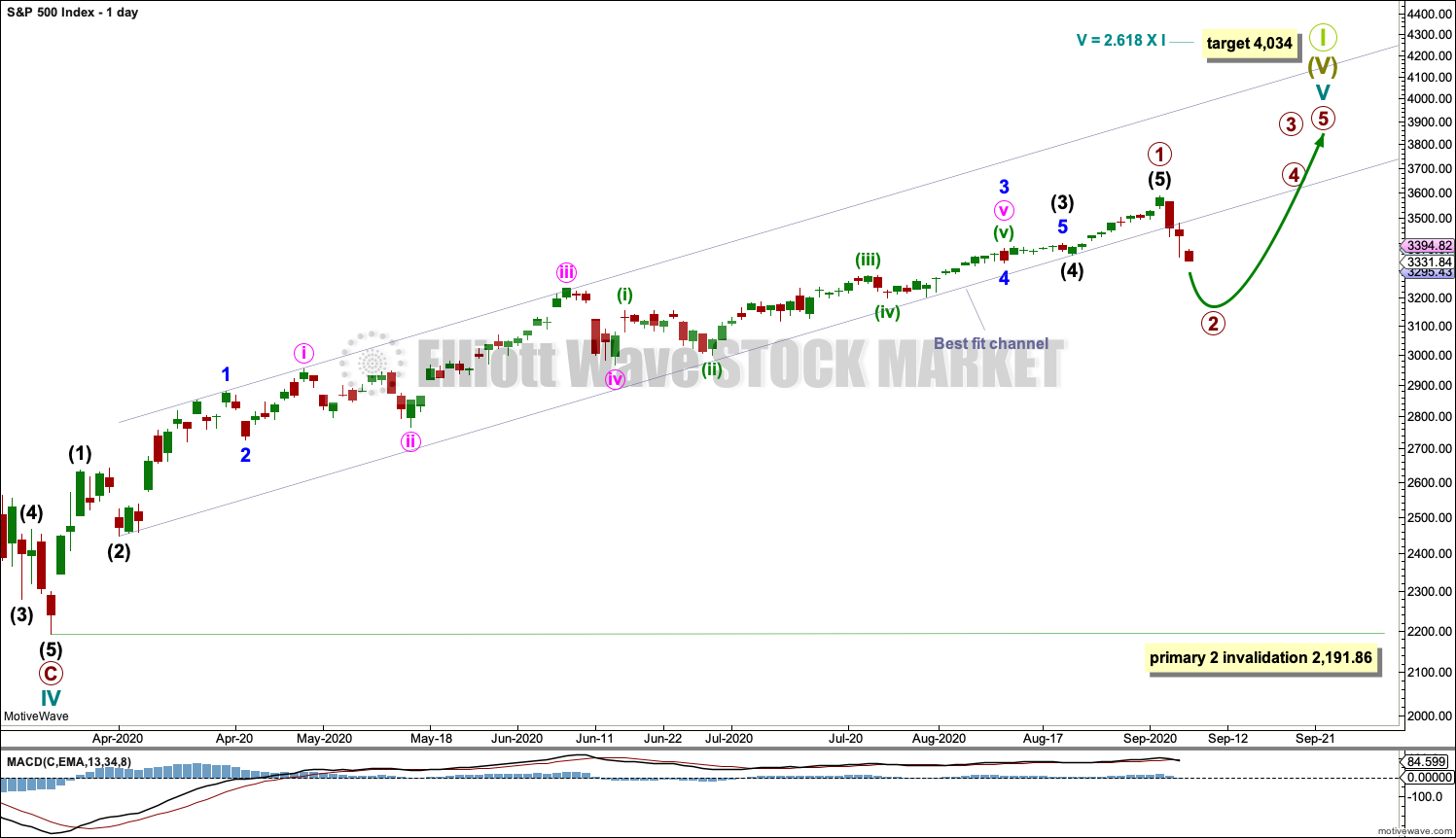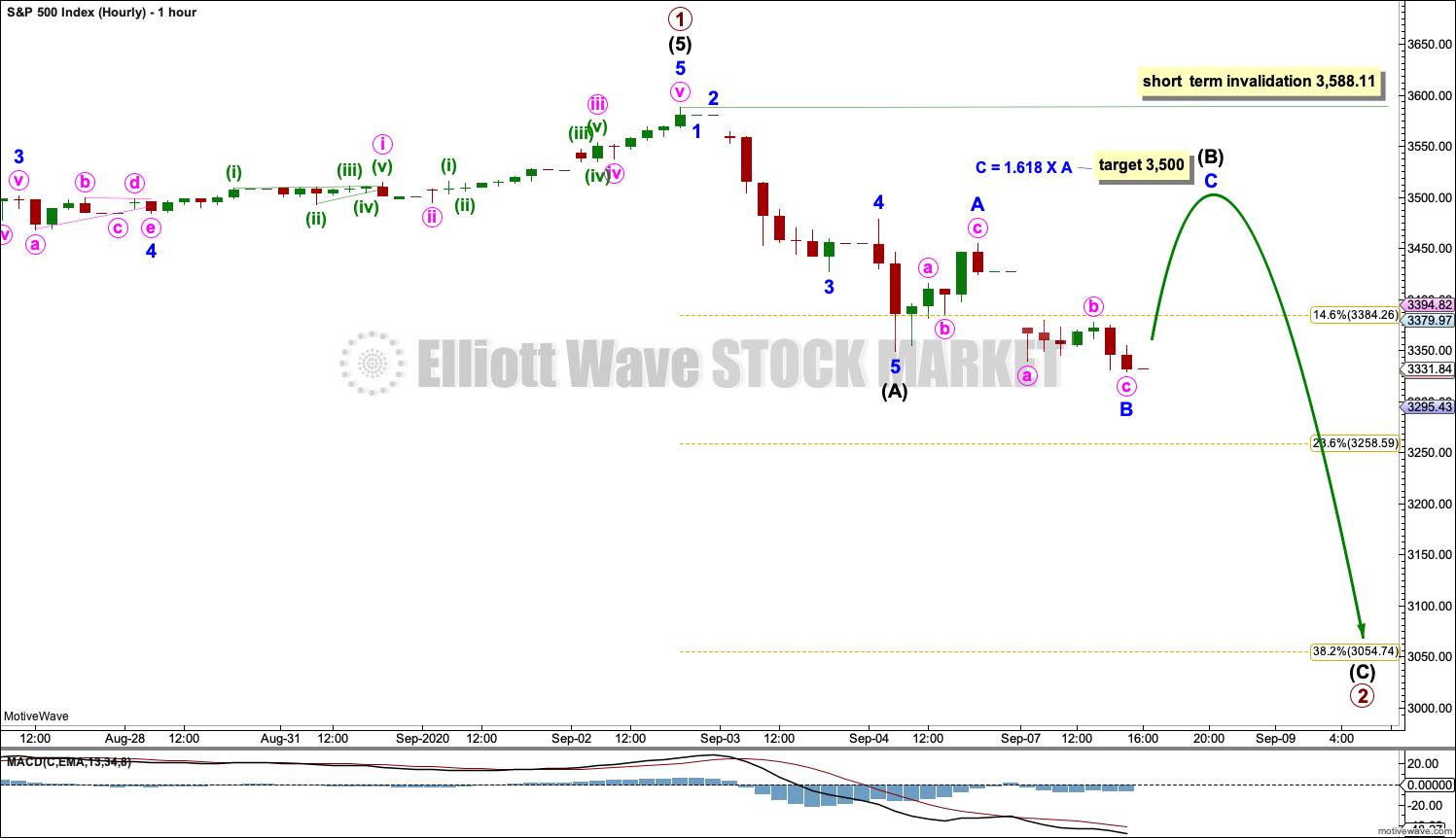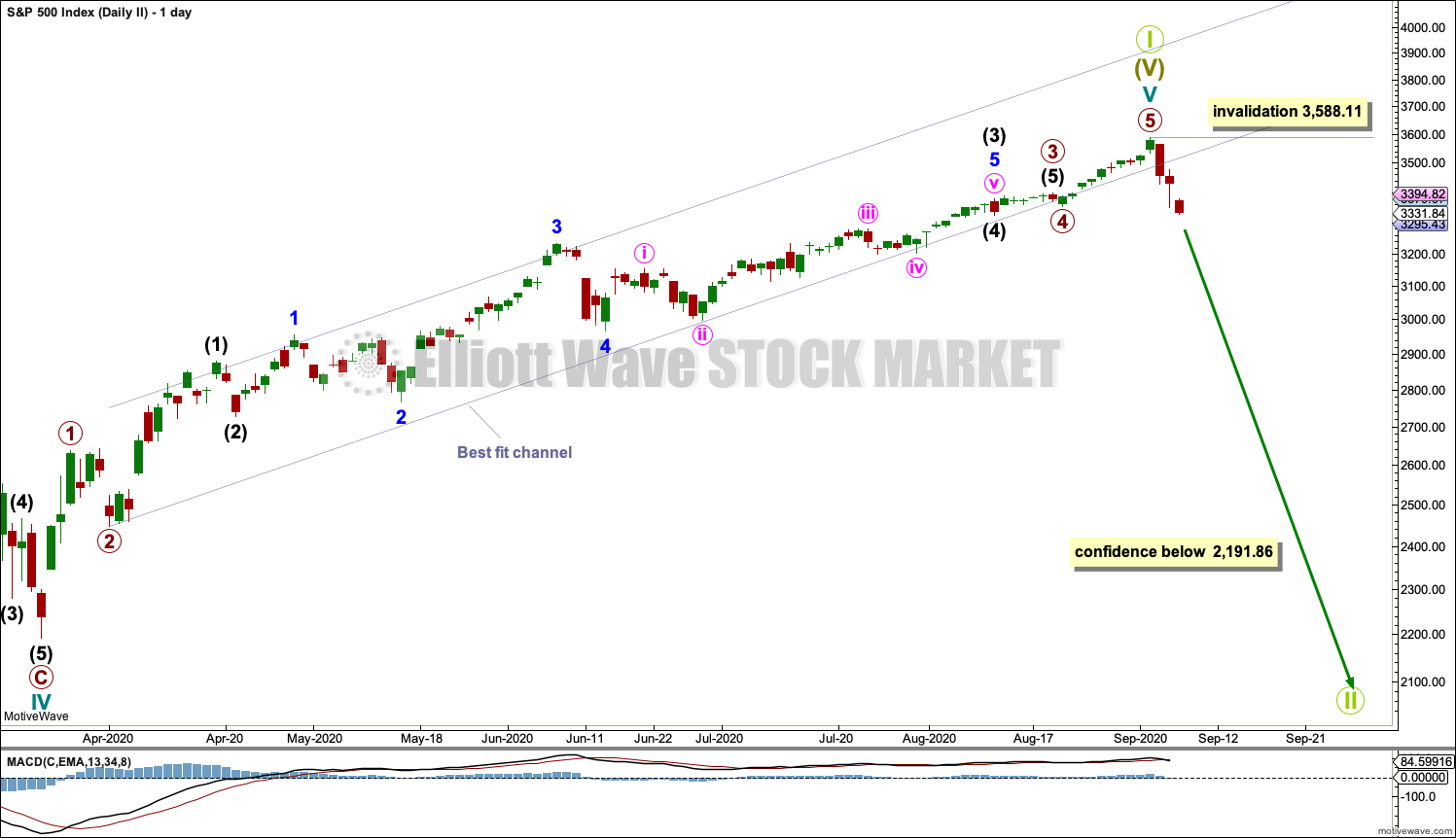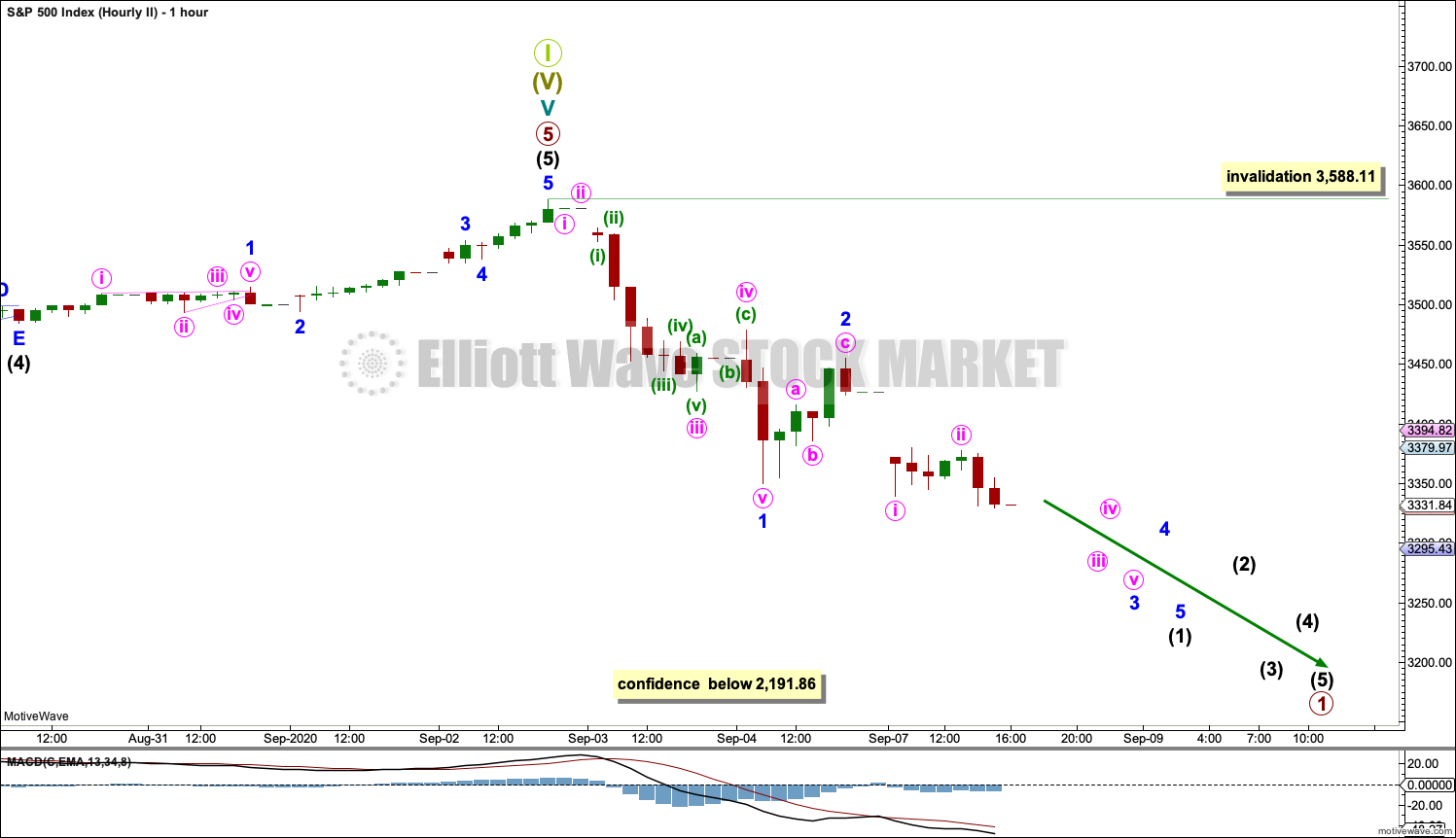S&P 500: Elliott Wave and Technical Analysis | Charts – September 8, 2020
A very short-term bounce was expected but did not eventuate. For the mid term, both Elliott wave counts have expected downwards or sideways movement this week.
Summary: Downwards or sideways movement may continue.
The first wave count expects that a pullback or consolidation to last about one to a few weeks has begun. It may find support about 3,259, 3,055 or 2,725.
The second wave count considers the possibility that a once in multi-generations trend change may have just occurred. Some confidence in this wave count would come with invalidation of the first wave count below 2,191.86.
The biggest picture, Grand Super Cycle analysis, is here.
Monthly charts are here, with video here.
ELLIOTT WAVE COUNTS
FIRST WAVE COUNT
WEEKLY CHART
Cycle wave V may last from one to several years. So far it has lasted 6 months.
Cycle wave V would most likely subdivide as an impulse. But if overlapping develops, then an ending diagonal should be considered. This chart considers the more common impulse.
Primary wave 1 may be complete. Primary wave 2 may not move beyond the start of primary wave 1 below 2,191.86.
There is already a Fibonacci ratio between cycle waves I and III within Super Cycle wave (V). The S&P500 often exhibits a Fibonacci ratio between two of its actionary waves but rarely between all three; it is less likely that cycle wave V would exhibit a Fibonacci ratio. The target for Super Cycle wave (V) to end would best be calculated at primary degree, but that cannot be done until all of primary waves 1, 2, 3 and 4 are complete. The target at 4,034 is provisional, so it may change.
DAILY CHART
A target is calculated for intermediate wave (5) to complete primary wave 1, based upon the most common Fibonacci ratio to intermediate wave (1).
The best fit channel is breached by clearly downwards movement. This adds confidence in a trend change, at least for the short or mid term.
Primary wave 1 may be over and primary wave 2 may have begun.
Primary wave 2 may be a multi-week pullback or consolidation. Primary wave 2 may not move beyond the start of primary wave 1 below 2,191.86.
HOURLY CHART
Primary wave 2 may have begun. It would most likely subdivide as a zigzag, but it may subdivide as any Elliott wave corrective structure except a triangle.
A correction at primary degree should begin with a five wave structure downwards at the hourly chart level, which may be complete and is labelled intermediate wave (A). This degree of labelling may need to be moved down one degree this week depending upon how primary wave 2 unfolds.
A five wave structure downwards should then be followed by a three wave structure upwards, which may not move beyond the start of the five down. This will at this stage be labelled intermediate wave (B).
Intermediate wave (B) may subdivide as any Elliott wave corrective structure. Intermediate wave (B) may not move beyond the start of intermediate wave (A) above 3,588.11.
Intermediate wave (B) may be subdividing as an expanded flat. There is some support for this today from technical analysis: price is falling faster than VIX is rising (this bullish short-term divergence between price and VIX supports the view that downwards movement today may be minor wave B within intermediate wave (B) ).
So far minor wave B within the expanded flat would be a 1.19 length to minor wave A. This is within the common range of 1 to 1.38 times the length of minor wave A. Minor wave C would be likely to make at least a slight new high above the end of minor wave A at 3,455.13. At 3,500 minor wave C would reach 1.618 times the length of minor wave A.
If this wave count is wrong for the short term, then it would be in expecting intermediate wave (B) to continue higher. Expect any surprises to be to the downside at this time.
If downwards movement continues when markets open tomorrow, then intermediate wave (B) would be considered complete at the high labelled minor wave A.
SECOND WAVE COUNT
DAILY CHART
This wave count is the same as the first wave count with the exception of the degree of labelling within cycle wave V. If the degree of labelling is moved up one degree, then it is possible that cycle wave V to end Super cycle wave (V) to end Grand Super Cycle wave I is complete.
A new low below 2,191.86 would add confidence in this wave count. At that stage, the first wave count would be invalidated.
A new bear market at Grand Super Cycle degree may be expected to last over a decade. It may take price below the start of Super Cycle wave (V) at 666.79 in March 2009.
HOURLY CHART
It is possible that a Grand Super Cycle degree trend change may have occurred last week.
The first five down within the new trend is labelled minor wave 1. Minor wave 2 may not move beyond the start of minor wave 1 above 3,588.11.
TECHNICAL ANALYSIS
WEEKLY CHART
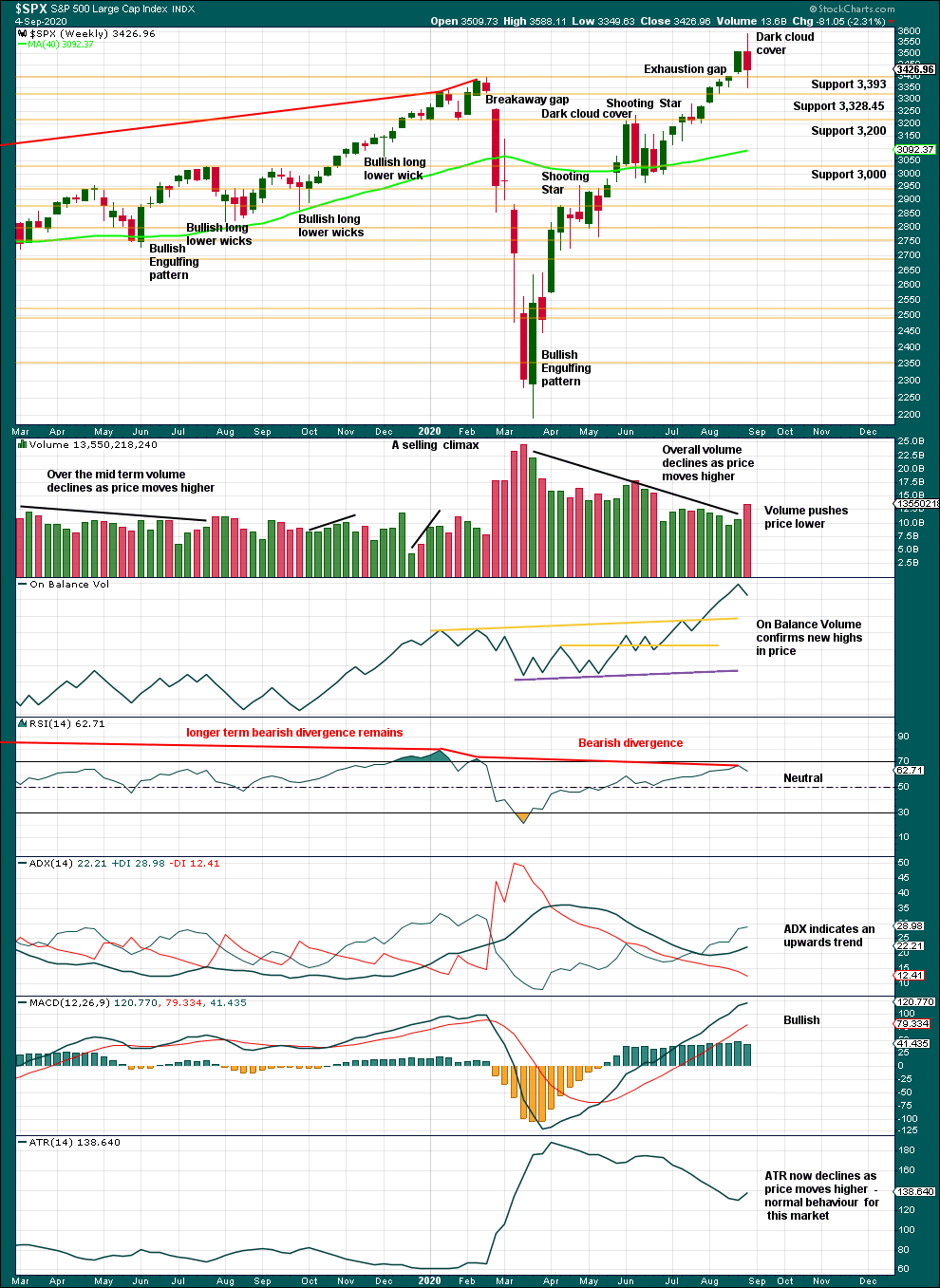
Click chart to enlarge. Chart courtesy of StockCharts.com.
ADX indicates an upwards trend. However, with RSI exhibiting bearish divergence and last week’s bearish candlestick reversal pattern having support from volume, further pullback or consolidation at least for the short term may be expected here.
DAILY CHART
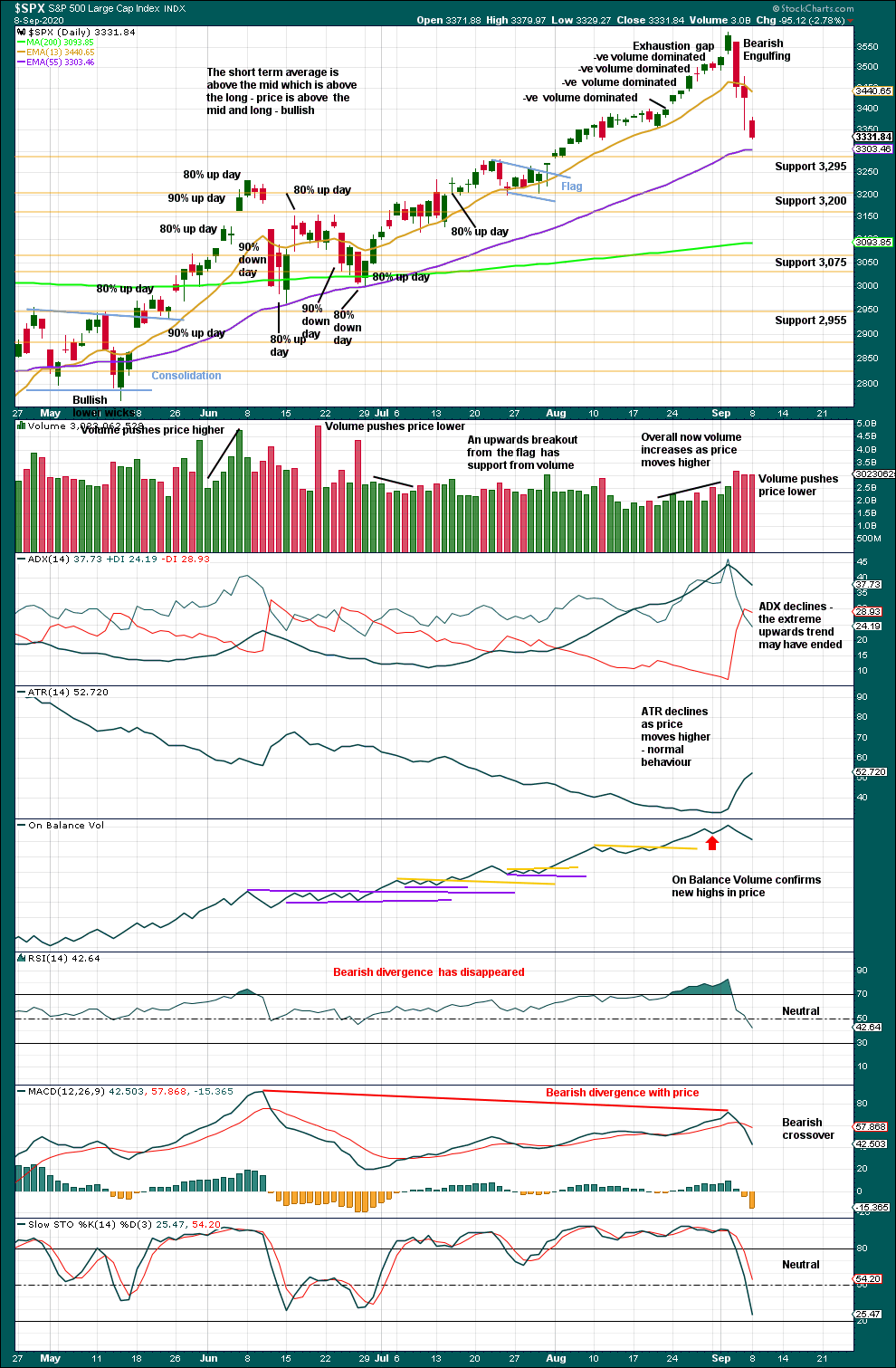
Click chart to enlarge. Chart courtesy of StockCharts.com.
Down volume dominated for four sessions within the last nine sessions in a row of upwards movement.
RSI and ADX both reached extreme.
In extreme conditions a bearish candlestick pattern should be given weight; a trend change should be expected to be either downwards or sideways. Bearish candlestick patterns make no comment on the direction of the next trend (either a consolidation to relieve extreme conditions or a full 180° reversal) nor on how long the new trend may last.
The bearish candlestick pattern has support from volume. However, three prior Bearish Engulfing patterns can be seen on this chart on 12th of May, 11th June and 11th of August. None were followed by any substantial downwards movement; all were short-term corrections within an ongoing upwards trend.
A new low below 3,354.69 gives some confidence in a trend change.
Expect price to continue to fall overall until it finds support and at the same time Stochastics reaches oversold. Support lines are noted on the chart.
BREADTH – AD LINE
WEEKLY CHART

Click chart to enlarge. Chart courtesy of StockCharts.com. So that colour blind members are included, bearish signals will be noted with blue and bullish signals with yellow.
Breadth should be read as a leading indicator.
Lowry’s Operating Companies Only AD line has still not made new all time highs. The last high for the OCO AD line was in the week beginning January 13, 2020. There is now 7 and a half months of bearish divergence between price and the OCO AD line. This may now support the more bearish second wave count. It is possible now that a major trend change may occur.
The NYSE All Issues AD line made new highs in the week beginning 1st of June.
Last week both price and the AD line have moved lower. There is no new divergence.
Large caps all time high: 3,588.11 on September 2, 2020.
Mid caps all time high: 2,109.43 on February 20, 2020.
Small caps all time high: 1,100.58 on August 27, 2018.
This rise has been led by large caps, which is a feature of an aged bull market. Only large caps have made new highs above the last swing high of the 11th of August.
DAILY CHART
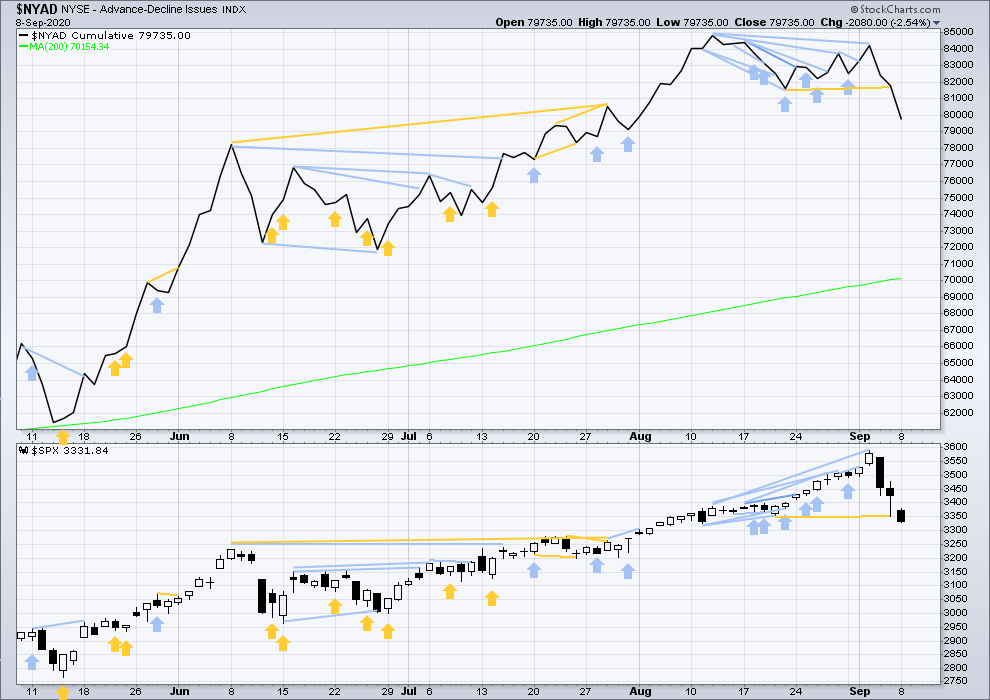
Click chart to enlarge. Chart courtesy of StockCharts.com. So that colour blind members are included, bearish signals will be noted with blue and bullish signals with yellow.
Both price and the AD line have moved lower on Monday. Bullish divergence noted in last analysis has not been followed by upwards movement and no longer remains, so it is considered to have failed. There is no new divergence.
VOLATILITY – INVERTED VIX CHART
WEEKLY CHART

Click chart to enlarge. Chart courtesy of StockCharts.com. So that colour blind members are included, bearish signals will be noted with blue and bullish signals with yellow.
Inverted VIX remains well below all time highs. The all time high for inverted VIX was in the week beginning October 30, 2017. There is nearly 3 years of bearish divergence between price and inverted VIX. There is all of long, mid and short-term bearish divergence.
Both price and inverted VIX have moved lower last week. Inverted VIX has made a strong new low below the low of the week beginning 21st of July, but price has not. This divergence is bearish.
Comparing VIX and VVIX: From weeks beginning 1st June to three weeks ago, VIX has made new lows as price has made new highs, but VVIX has failed to make corresponding new lows with VIX. VVIX remains slightly elevated. This divergence is not strong, but it is bearish for price.
DAILY CHART

Click chart to enlarge. Chart courtesy of StockCharts.com. So that colour blind members are included, bearish signals will be noted with blue and bullish signals with yellow.
Both price and inverted VIX have moved lower to start the new week. Price has made new lows, but inverted VIX remains elevated. This divergence is bullish for price for the short term.
Comparing VIX and VVIX at the daily chart level: Both have moved higher today. There is no new divergence.
DOW THEORY
Dow Theory still concludes a bear market is in place.
Dow Theory confirmed a bear market with the following lows made on a closing basis:
DJIA: 21,712.53 – a close below this point was been made on the March 12, 2020.
DJT: 8,636.79 – a close below this point was been made on March 9, 2020.
Adding in the S&P and Nasdaq for an extended Dow Theory, a bear market was confirmed:
S&P500: 2,346.58 – a close below this point was made on March 20, 2020.
Nasdaq: 7,292.22 – a close below this point was made on the March 12, 2020.
At this time, to shift Dow Theory from viewing a bear market to confirmation of a new bull market would require new highs made on a closing basis:
DJIA: 29,568.57
DJT: 11,623.58
Adding in the S&P and Nasdaq for an extended Dow Theory, confirmation of a bull market would require new highs made on a closing basis:
S&P500: 3,393.52 – closed above on 21st August 2020.
Nasdaq: 9,838.37 – closed above on June 8, 2020.
Published @ 06:09 p.m. ET.
—
Careful risk management protects your trading account(s).
Follow my two Golden Rules:
1. Always trade with stops.
2. Risk only 1-5% of equity on any one trade.
—
New updates to this analysis are in bold.


